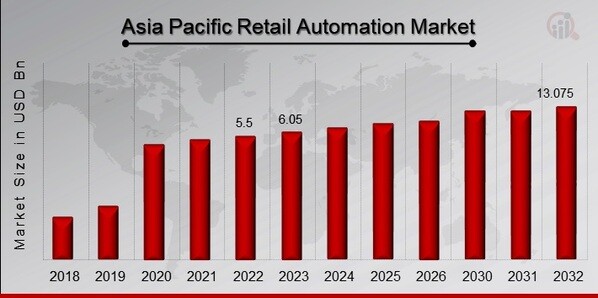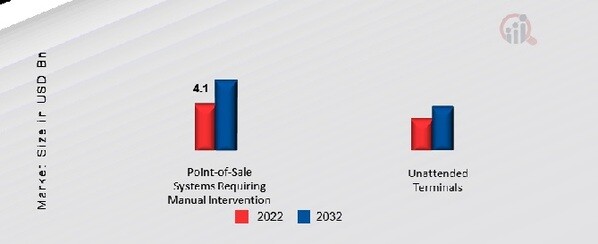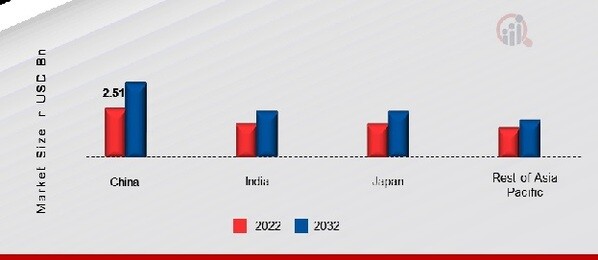Asia Pacific Retail Automation Market Size was valued at USD 5.5 Billion in 2022. The retail automation market industry is projected to grow from USD 6.05 Billion in 2023 to USD 13.075 Billion by 2032, exhibiting a compound annual growth rate (CAGR) of 10.10% during the forecast period (2023 - 2032). The rising need for sophisticated automated systems in retail throughout Asia Pacific is a main market driver propelling the growth of the retail automation industry. Its many advantages—including accuracy, affordability, high-caliber performance, and speed—have expedited industry growth.

Source: Secondary Research, Primary Research, MRFR Database and Analyst Review
Retail Automation Market Trends
Growing demand for handheld barcode readers and scanners to accelerate market growth
One of the major trends in the Asia Pacific retail automation market is the rising demand for handheld barcode readers and scanners across a variety of business verticals, such as transportation and logistics, warehousing, healthcare, hospitality, oil and gas, etc. Handheld barcode readers/scanners, for example, make inventory management and asset tracking easier. Because they are portable and light, handheld barcode readers and scanners are perfect for end users such as warehouses who need to cover wide regions. Additionally, the cost of portable barcode readers is lower than that of stationary barcode readers and scanners. Handheld barcode readers and scanners are being adopted by a number of retailing companies, including Tesco, Carrefour, Metro, and Wal-Mart Stores. Due to its portability, handheld barcode readers and scanners can read and scan both two- and one-dimensional barcodes. Because of the device, businesses can save money on maintenance. Even small businesses may easily adopt and upgrade to a modern asset and inventory management system because of the device's low cost. Furthermore, iOS or Android-based mobile devices, including tablets, smartphones, and laptops, can now be easily connected to portable barcode readers and scanners. This enables the gadget to scan and store real-time data, which facilitates data management.
The rise of e-commerce has made delivery rivalry amongst these businesses more intense. The increasing use of e-commerce automation, which does things like standardize visual merchandising, manage high-risk orders, track and report more easily, and automatically classify customers for marketing purposes, will therefore be a big factor in the market's growth in the upcoming years. Additionally, because e-commerce solutions simplify business operations and distribution networks and create opportunities for profitable new revenue streams, retailers are becoming more demanding when it comes to automation. Digital stock level and inventory status tracking, as well as change notifications, are made possible by the inventory and order management systems provided by e-commerce automation solutions. Because of this, inventory management goes more quickly and the retail industry never experiences a shortage of inventory. Therefore, it is anticipated that over the projected period, the retail automation market will rise as a result of the globalization of e-commerce operations. Thus, driving the retail automation market revenue.
Retail Automation Market Segment Insights
Retail Automation Product Type Insights
The Asia Pacific Retail Automation market segmentation, based on product type includes Point-of-Sale Systems Requiring Manual Intervention and Unattended Terminals. The point-of-sale systems requiring manual intervention category led the market in 2022 impacted by elements such as product complexity, distinct client contacts, or particular industry requirements. Additionally, the survival of manual involvement in some Point-of-Sale systems within the retail automation market may be attributed to factors like the integration of cutting-edge technologies, the requirement for customization, or specialized markets.
Figure 1: Asia Pacific Retail Automation Market, by Product Type, 2022 & 2032 (USD Billion)

Source: Secondary Research, Primary Research, MRFR Database and Analyst Review
Retail Automation Product Insights
The Asia Pacific Retail Automation market segmentation, based on product, includes Barcode Reader, Weighing Scale, Currency Counter, Bill Printer, Cash Register, Card Reader, Kiosks, Self-Checkout Systems, and Others. The barcode reader category generated the most income because of the growing need for improved operational accuracy, expedited checkout processes, and effective inventory management in retail settings. Rapid and precise data collection is made possible by this technology, which enhances customer satisfaction and overall operational effectiveness. The continued trend of automation in retail is probably going to encourage more people to use barcode readers, which will help the market as a whole grow.
Retail Automation End-user Application Insights
The Asia Pacific Retail Automation market segmentation, based on end-user application, includes Food/Non-Food, Oil and Gas, Transportation and Logistics, Health and Personal Care, Hospitality, and Others. The transportation and logistics category generated the most income because of the growing need for effective supply chain management. Automation technologies save costs and increase customer satisfaction by optimizing workflows, enhancing inventory control, and improving overall logistics. This expansion has been further fueled by the integration of cutting-edge technologies like IoT, RFID, and AI, which enable real-time visibility and data-driven decision-making in the transportation and logistics sector within retail automation.
Retail Automation Country Insights
During the course of the projection period, the Asia-Pacific area is increasing at a notable rate. The retail business has a significant opportunity to realize new levels of productivity throughout its whole value chain due to the increasing number of connected devices and the IoT. In terms of sophisticated applications, China's smart warehouse market has grown significantly. China is one of the countries that uses industrial robots the most, and demand for these machines is only growing. In addition, the requirement to develop distinctive and captivating in-store experiences along with an increase in grocery sales via e-commerce platforms are anticipated to fuel the market's expansion in Asia-Pacific. Furthermore, automation adoption in this region is predicted to increase due to the swift and comprehensive disruptions of retail business models brought about by innovative ideas and rapid technical improvements.
Figure 2: ASIA PACIFIC RETAIL AUTOMATION MARKET SHARE BY REGION 2022 (USD Billion)

Source: Secondary Research, Primary Research, MRFR Database and Analyst Review
Retail Automation Key Market Players & Competitive Insights
Leading market players are investing heavily in research and development in order to expand their product lines, which will help the retail automation market, grow even more. Market participants are also undertaking a variety of strategic activities to expand their footprint, with important market developments including new product launches, contractual agreements, mergers and acquisitions, higher investments, and collaboration with other organizations. To expand and survive in a more competitive and rising market climate, retail automation industry must offer cost-effective items.
Major players in the retail automation market are attempting to increase market demand by investing in research and development operations includes Datalogic S.p.A., Diebold Nixdorf, Fiserv, Inc., Fujitsu Limited, Honeywell International Inc., KUKA AG, NCR Corporation, Seiko Epson Corporation, Toshiba Global Commerce Solutions, and Zebra Technologies.
Key Companies in the retail automation market include
-
-
Diebold Nixdorf
-
-
Fujitsu Limited
-
-
KUKA AG
-
NCR Corporation
-
Seiko Epson Corporation
-
Toshiba Global Commerce Solutions
-
Zebra Technologies
Retail Automation Industry Developments
December 2020: Zippin and Fujitsu Limited teamed to provide the company's checkout-free solution throughout Japan. Through the collaboration, Fujitsu will be able to create a retail solution that offers a unique customer experience by utilizing Zippin's checkout-free SaaS platform with cashless operations. The businesses saw this as especially crucial during the pandemic, as it will increase bandwidth and save staff time.
January 2020: In order to enhance the functionality of its barcode scanner, Honeywell International Inc. collaborated with KOAMTAC Inc. to include a barcode decoder through the SwiftDecoderTM software. SwiftDecoder is less expensive than a dedicated barcode scanner, although it is significantly slower and less convenient when utilizing the camera on a tablet or smartphone.
Retail Automation Market Segmentation
Retail Automation Product Type Outlook
Retail Automation Product Outlook
-
Barcode Reader
-
Weighing Scale
-
Currency Counter
-
Bill Printer
-
Cash Register
-
Card Reader
-
Kiosks
-
Self-Checkout Systems
-
Others
Retail Automation End-user Application Outlook
Retail Automation Regional Outlook
-
Asia-Pacific
-
China
-
Japan
-
India
-
Australia
-
South Korea
-
Indonesia
-
Thailand
-
Vietnam
-
Malaysia
-
Singapore
-
Rest of Asia-Pacific





























